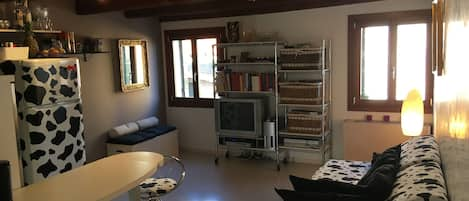A lovely self-catering apartment situated on the second floor (fifteen steps up) in a characteristic building of Venice, near by the Biennale International Art Exhibition: it is brand new and well-lit with completely new furnishings. This flat is made up of an ample living room with wood beams, a fully equipped angle for cooking and one double bedroom; it has a new bathroom with shower and there is a double sleeper sofa in the living room. Free Internet WiFi access is available with ultra broadband FTTH fiber optic technology and SMART TV.
CHECK-IN: no later than 10:30 PM (22:30)
CIN: IT027042C2ACTZZXXP
Please note: the TOURIST TAX is not included in the rental amount. the TAX will be paid in cash on the day of your arrival and it is only due for the first five nights of your stay calculated per person. At the moment, considering the high season, the tax is 3,00 € per person per night. The tax is calculated by applying the rate set by the Municipality of Venice.
There are large, bright windows throughout the entire apartment.
The windows of the living room and face a little venetian square in the district called Castello.
The area is quite and very easy to reach, because it is a few minutes from the vaporetto stop called “Giardini”, no bridge to cross to get to. Close by there is the street “Via Garibaldi” full of well-stocked shop, bars, restaurants. The public water-bus stop (“Giardini”) is very important: many lines stop there (number 1-2-4.1-4.2-5.1-5.2-6-N night line) and assure any link in Venice and for the others islands (Murano, Burano, etc.).
Apartment consists of one bedroom with a double-bed, a large living-room with a furnished kitchenette and with a double sofa-bed and the bathroom (with shower). Self-catering.
About the flat...: This apartment is ideal for people looking for a romantic and cultural holiday in Venice. You can easily walk to Saint Mark's square and interesting places of the city from this location, but far from noisy tourist quarters. The position is enchanting, close to the “Giardini” water bus stop (2 stops after San Marco), and also easy to reach the Lido beach. Very close you will find Via Garibaldi which is full of shops of every kind, bars, restaurants. The Giardini (Gardens of Venice) are known for the Biennale Art Exposition.
some friends wrote me...: 'We have very much enjoyed our week here. The apartment is lovely and felt like our own home in Venezia. Great location too. The Giardini-Biennale vaporetto stop has to be the prettiest in town and we liked the feeling of being in a genuine neighbourhood rather than amongst all the (other!) tourists.'
'Dear Frank, lovely apartment, enjoyed a great week in Venice. lovely the local market on via Garibaldi. Got everything we needed for self catering.







